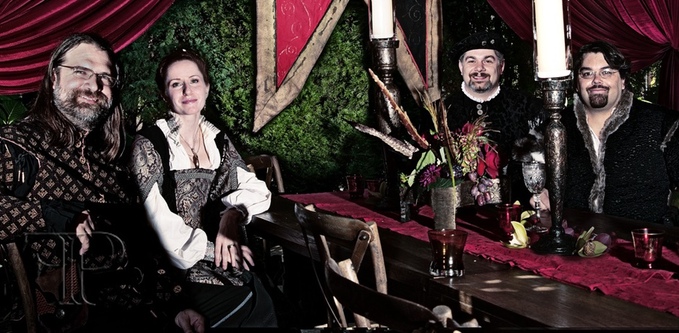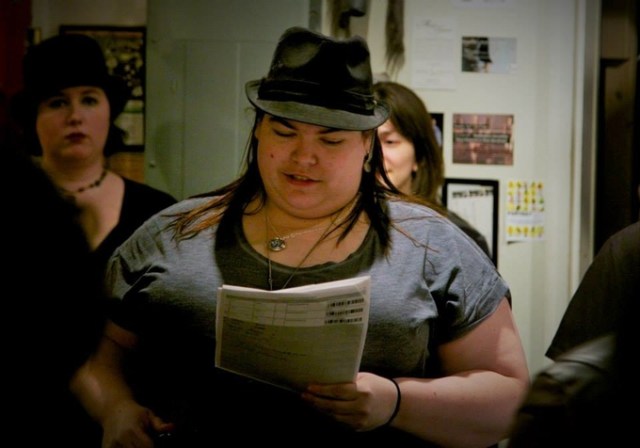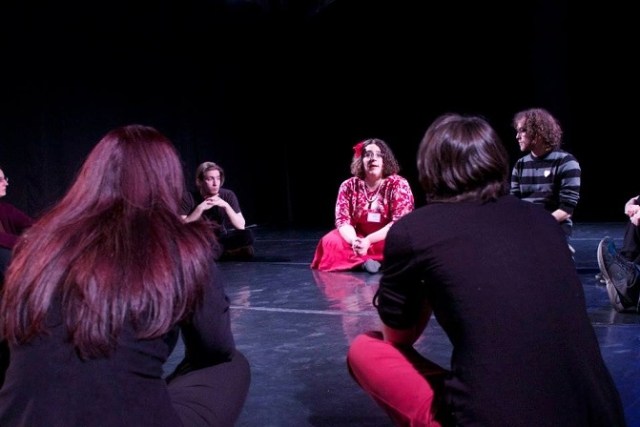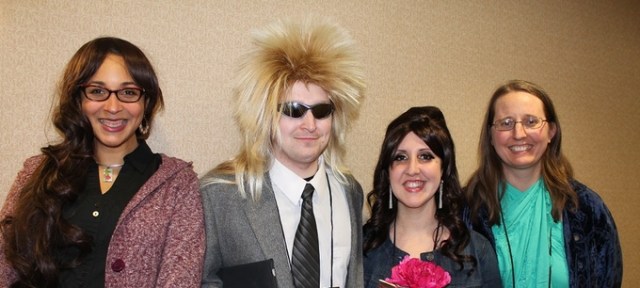For those interested in live action role playing (or larp), there’s an exciting event coming up (May 2016 in Austin, TX) that you won’t want to miss: the Living Games Conference. Described as “a conference devoted to the academic and practical study of larp in all forms,” this innovative conference draws from international and domestic influences and seeks to advance theory and application of larp best practices and development. In other words, there will be lots of gaming, but there will also be lots of panels and workshops to help larp creators hone their craft. This is the kind of event for committed larp aficionados and newbies alike!
The conference recently had a fundraiser on Kickstarter with fantastic rewards for backers. Registration is open now. The following is an interview about the conference with Sarah Lynne Bowman, Ph.D., the lead organizer of the Living Games Conference.
K.N. Granger (TMS): This is the second Living Games Conference; there was previously one in 2014 at NYU. How did the first one come to be?
Sarah Lynne Bowman: Yes, we’re very excited to continue the momentum started by the previous Living Games! The first conference was Shoshana Kessock’s Master’s thesis project at NYU. I was happy to join Jaakko Stenros, Evan Torner, Emily Care Boss, and Nick Fortugno on the programming team for that endeavor. Evan, Emily, and Nick are helping us with the current Living Games as well, along with Lizzie Stark, who is heading up programming, Steve Vig, as well as many other contributors. Several of our presenters and attendees for this year’s conference were also present at the first Living Games.
The idea behind Living Games is to wed academic theory with practice. Inspired by the Nordic larp conference—this year, called Solmukohta—Living Games features keynotes, panels, workshops, and roundtables during the day, with larps and social events in the evening. In this respect, we are expanding the vision to encompass more spaces and more panel tracks, as well as a higher attendance at a major hotel. We hope that Living Games will continue to grow and evolve in future years.
TMS: One of the unique things about this con is that it focuses on live-action role playing (larp). There aren’t many larp-only conventions in the United States; the only one I can think of is Intercon. How did people respond when you began working on this?
Bowman: Another significant convention with a larp focus is Wyrd Con, for whom I edit the yearly Wyrd Con Companion Book. Attendees can also larp at Double Exposure events, Midwinter Gaming Convention, Big Bad Con, and other fine conventions across the States.
Living Games is more conference than convention due to its emphasis on building a knowledge community through presentations and discussion, as well as our academic track. This year, for example, we are teaming up with Anne Standiford at Texas State University to run a Role-playing and Simulation in Education mini conference right before the start of Living Games, where practitioners in experiential learning can share research and best practices. We are offering scholars the opportunity to publish in a peer-reviewed conference proceeding. In that regard, we hope to become a central meeting place for people interested in pursuing a career in larp as a designer, educator, or organizer. We also hope to become a place for interested newcomers to learn more about larp and its relationship to adjacent fields, such as interactive theatre, simulation, tabletop, video gaming, etc. We want to encourage people from all larp communities to attend, from boffer to freeform to Nordic to theatre style. Our conference theme this year is Sharing Insights, so we definitely would like people from many backgrounds to attend. We are planning Larp Theory and Design 101 sessions to get everyone on the same page.
TMS: I like the fact that this con moves around from city to city – what factored into that decision?
Bowman: In many ways, we’re patterning Living Games upon the Nordic convention, which alternates between four Scandinavian countries each year: Finland, Norway, Sweden, and Denmark. The idea behind the changing location is that each year, a new organizing committee will bring fresh ideas and a taste of their local subcultures to the conference. We’re hoping this idea will take hold here in the States as well, as the U.S. has many fascinating larp cultures in different pockets of the country. Here in Austin, we have Dystopia Rising: Lone Star, Amtgard, and Planetfall, among others. We’d love to travel to another city for Living Games 2017 and learn about their local larps.
TMS: What are some of the things you’re most excited about presenting at Living Games?
Bowman: We have an amazing group of keynote speakers who will deliver short, powerful presentations, including Michael Pucci and Ashley Zdeb from Dystopia Rising; Claus Raasted from College of Wizardry; Susan Weiner of Alleged Entertainment, Jason Morningstar of Bully Pulpit Games, and many other incredible voices. We’ve also been able to establish some of our first panel topics, which include: puzzle rooms; gender/sexuality in larp; larp as art; safety in larp communities; making a living through larp; therapeutic applications; larp and technology; the connections between larp and tabletop, etc. These ideas are just a sample of what is evolving into a phenomenal program. Additionally, as I mentioned before, we have the Role-playing and Simulation in Education conference at Texas State, where scholars and teachers can collaborate. I could not be more excited!
TMS: What are you doing to maximize accessibility for people with disabilities at this con?
Bowman: The Holiday Inn Midtown is fully accessible, with 9 accessible meeting rooms and 8 wheelchair accessible guest rooms. For a complete list of accessibility features at the hotel, see this link.
TMS: This con is taking place in Texas. What are you doing to encourage inclusion at this con, particularly for people of color and women?
Bowman: Austin, Texas is actually an incredibly progressive town for the region. Our city motto is Keep Austin Weird. Many of the people who live here are artists, tech geeks from California, and people affiliated with the University of Texas, one of the largest public universities in America.
That being said, issues of structural inequality still exist in Austin, as they do everywhere in the States. One of our big goals is to encourage diversity in our presenters and attendees, including women, people of color, people with disabilities, alternative gender identities and sexualities, ethnicities, etc. We have robust Code of Conduct that outlines clear expectations for decorum, as well as some suggestions for encouraged behaviors. Our safety team is well-equipped to handle issues if they arise.
TMS: What’s your favorite kind of larp? Do you have any favorite authors that you’d like to signal-boost?
Bowman: I try not to play favorites. I enjoy many different kinds of larp, including Dystopia Rising, Planetfall, Nordic larps like the recent Just a Little Lovin’ in Denmark, American freeform, and College of Wizardry in Poland, which I plan to attend over Thanksgiving. My personal preferences are not terribly important to the conference, however. We’ve worked hard to be inclusive of many different larp styles, inviting people to speak from Amtgard, the Mind’s Eye Society, and Intercon, among others. In my view, we cannot promote larp as a whole unless we support everyone’s creative efforts, not just those of a select few.
TMS: How have you been influenced, if at all, by European larp, such as Nordic?
Bowman: Definitely. I have attended the Nordic larp conference for the last five years and find it to be one of the most inspiring places for creative people to meet that I have ever experienced. We are blessed to have keynoters presenting from that community, including Claus Raasted and Eirik Fatland. Living Games is a way for us to try to create a similarly collaborative space in the United States with a wider umbrella to include more traditional style games alongside the avant-garde. We can all learn from one another.
TMS: So, larp theory. What are some of the prominent conversations you’re having in this area, and how could a newbie start engaging in these discussions?
Bowman: That’s a big question! One of the major topics for me lately involves psychological safety, including bleed, debriefing, consent, and post-larp depression—or “blues” as some prefer to call it. I’m also quite involved in the educational aspects of role-playing, haven written recent peer-reviewed papers on the topic, including a literature review and a case study with Anne Standiford. I’ve started writing and implementing edu-larps in my Humanities classroom at Austin Community College, as well as aiding Anne in developing simulations for psychiatric nursing at Texas State. There are tons of other interesting topics pertaining to larp.
For people new to the field looking for reading, I suggest checking out my book The Functions of Role-playing Games, the Wyrd Con Companion Book, Analog Game Studies, the Nordic larp conference books, and documentation anthology. We also have plenty of stimulating environments on social media for conversations pertaining to larp, including Larp Haven, Edu-larp Sharing is Caring, North American and Nordic Larp Exchange, the Role-play Theory Study Group, etc. It’s an amazing time to be a larper!
TMS: Is there anything you’re worried about, as you’re working on putting together Living Games? How can we help?
Bowman: We ran a Kickstarter in order to sell tickets and help fulfill our hotel contract. We have experienced amazing support from the community. We offered backers tickets, consultations from experts in the field of larp, bundles of larps, and Assistance Points (AP) for Dystopia Rising and Planetfall games. We will also put together a Living Games Hub after the conference for videos, Powerpoints, the conference proceeding, and other materials generated by the event. That way, even if backers are unable to attend, they can still stay connected remotely and support a great cause. We would very much appreciate any support readers are willing to give!
Learn more about the Living Games Conference and register here.
(images via Living Games Kickstarter)
Sarah Lynne Bowman, Ph.D. is a role-playing studies scholar and adjunct professor in English, Communication, and Humanities. She is the author of The Functions of Role-playing Games, the editor of the Wyrd Con Companion Book, and the lead organizer of the Living Games Conference.
K.N. Granger is a queer white cis able-bodied person with a radical social-justice perspective towards games. When not writing, organizing, or playing games, K.N. engages in fanfiction, social justice, playing viola and piano, and other activities in New York City. Her games are available on DriveThruRPG and Amazon.com under the auspices of Goldfinch Games. If you would like me to consider writing a review of your game, Kickstarter, or gaming event, please email [email protected]. I practice affirmative action for traditionally marginalized populations in choosing what to cover. Also, if you like this article, please support me on Patreon—I don’t get paid for my writing otherwise: https://www.patreon.com/kngranger.
—The Mary Sue has a strict comment policy that forbids, but is not limited to, personal insults toward anyone, hate speech, and trolling.—
Follow The Mary Sue on Twitter, Facebook, Tumblr, Pinterest, & Google+.












Published: Mar 31, 2016 02:53 pm